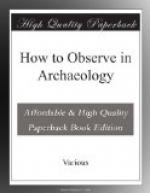LIST OF ILLUSTRATIONS AND TABLES
Some Hieroglyphic Signs liable to be confused with
each other
Flint Implements
Types of Greek Pottery, &c.
Greek Alphabets
Asia Minor Pottery types
Hittite Inscriptions, &c.
Bilingual (Greek and Cypriote) Dedication to Demeter
and
Persephone from Curium
Syrian Pottery.
Syrian Weapons, &c.
West Semitic Alphabets
West Semitic Numerals
Palestinian Pottery types
Egyptian Pottery types
Mesopotamian Pottery, Seals, &c.
Cuneiform and other Scripts
PREFACE
This Handbook is intended primarily for the use of travellers in the Near and Middle East who are interested in antiquities without being already trained archaeologists. It is the outcome of a recommendation made by the Archaeological Joint Committee, a body recently established, on the initiative of the British Academy and at the request of the Foreign Office, to focus the knowledge and experience of British scholars and archaeologists and to place it at the disposal of the Government when advice or information is needed upon matters connected with archaeological science. The Committee is composed of representatives of the principal English societies connected with Archaeology, and it is hoped that it may be recognized as the natural body of reference, both for Government Departments and for the public, on matters connected with archaeological research in foreign lands. It represents no one institution and no one interest. Its purpose is to protect the interests of archaeological science, to secure a sane and enlightened administration of antiquities in the lands which are now being more fully opened to research, and to promote the advance of knowledge in the spheres to which its competence extends.
One means of serving this cause is to provide information for the guidance of travellers in the lands of antiquity. Much knowledge is lost because it comes in the way of those who do not know how to profit by it or to record it. Accordingly, just as the Natural History Museum has issued a series of pamphlets of advice to the collectors of natural history specimens, so it has been thought that a handbook of elementary information and advice may be found of service by travellers with archaeological tastes; and the Trustees of the British Museum have undertaken the publication of it. The handbook has been prepared by a number of persons, whose competence is beyond dispute; and the thanks of all who find it useful are due to Mr. G. F. Hill (who has acted as general editor as well as part author), Prof. W. M. Flinders Petrie, Mr. D. G. Hogarth, Prof. J. L. Myres, Mr. J. G. C. Anderson, Mr. J. P. Droop, Prof. R. A. S. Macalister, Mr. H. R. Hall, Mr. A. J. B. Wace, Mr. 0. M. Dalton, Mr. R. L. Hobson, Mr. E. J. Forsdyke, Mr. A. H. Smith, Mr. R. A. Smith, Mr. A. B. Cook, and Prof. G. A. Cooke. Each contributor has been left considerable latitude as to the method of treatment of the subject allotted to him, and no attempt has been made to bring the various sections into uniformity of pattern. Owing to Prof. Petrie’s absence in Egypt, it has not been possible to submit final proofs of his contributions to him.




